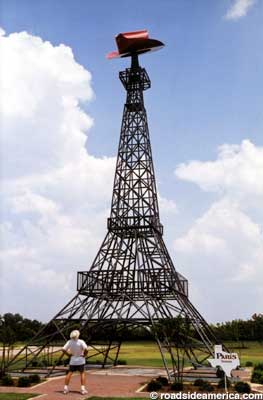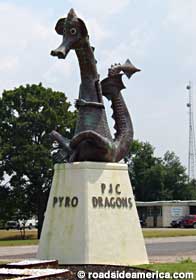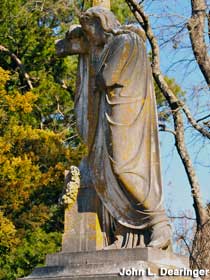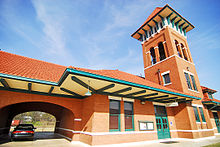For “Travel Tuesday”, Let’s visit Paris, TX, in The Texas Prairies and Lakes Region.
 “The Texas Prairies and Lakes Region offers a wide variety of destinations & attractions, from the fast-paced cosmopolitan excitement of the Dallas/Fort Worth Metroplex with the best in shopping, dining & entertainment, to the beautiful lakes & laid-back country lifestyles found throughout the region. Discover the Excitement of the Texas Prairies & Lakes.”
“The Texas Prairies and Lakes Region offers a wide variety of destinations & attractions, from the fast-paced cosmopolitan excitement of the Dallas/Fort Worth Metroplex with the best in shopping, dining & entertainment, to the beautiful lakes & laid-back country lifestyles found throughout the region. Discover the Excitement of the Texas Prairies & Lakes.”
_______
Paris, TX: "Second Largest Paris in the World."
Places of note
 Cox Field Airport
Cox Field Airport
“Cox Field Airport (IATA: PRX, ICAO: KPRX) is a general aviation airport located 6 miles East of Paris, Texas. The airport opened in August of 1943 as Cox Field and was used by the United States Army Air Forces as a training base. At the end of the war the airfield was determined to be excess by the military and turned over to the local government for civil use.”
_______
Lake Crook
“Lake Crook, managed by the City of Paris, offers picnic areas, boating and fishing. The dominant fish at Lake Crook are the Channel catfish, Largemouth bass and White Crappie. More Lake Crook Pics.
______
Trail de Paris
 “The Trail de Paris was the class project adopted by Leadership Lamar County Class 2004. The concept was, and is, to create a multi-use trail system along former railroad tracks and right of way. The initial 2.58 miles of trail is asphalt paved and beautiful to walk, jog or ride bike on. Future plans seem to be headed in the direction of expanding the trail through other cities to the east.”
“The Trail de Paris was the class project adopted by Leadership Lamar County Class 2004. The concept was, and is, to create a multi-use trail system along former railroad tracks and right of way. The initial 2.58 miles of trail is asphalt paved and beautiful to walk, jog or ride bike on. Future plans seem to be headed in the direction of expanding the trail through other cities to the east.”
______
Culbertson Fountain
 ”Culbertson Fountain is in the Historic District on the Plaza downtown. It was a gift to culminate the rebuilding of Paris after the Fire of 1916.
”Culbertson Fountain is in the Historic District on the Plaza downtown. It was a gift to culminate the rebuilding of Paris after the Fire of 1916.
Restored as a Bicentennial project, this fountain reigns not only as the unique focal point for Paris and Lamar County, but as "The Prettiest Plaza in the State of Texas." (Texas Monthly)
_______
Paris Union Station Railroad Depot
Historic Paris train station

”The Depot building is an outstanding example of station architecture representative of those along the Frisco Railroad Lines.
The building has been rehabilitated to house the Paris Economic Development Corporation and the research library of the Lamar County Genealogical Society.”
______
Lamar County Historical Museum
“The museum construction has virtually been built to date by a small group of volunteer workers. The Museum layout consists of 3 areas at this time, a Foyer with exhibition space, a central section with 6 galleries, and the rural life museum. The Foyer features the porch facade of the home of Judge Jim Noble Thompson, and cabinets from the former Staples Jewelry Store as well as the neon sign from the storefront. It will display more than 200 postcards with Paris scenes.
The various galleries will include a military room, which will consist of artifacts from the various wars fought by Lamar Counties from the Texas Revolution to the War in Iraq. There will be a gallery for African Americans, a changing gallery to take advantage of participation by smaller communities in the county, a room for artifacts concerning the Great Fire of 1916 and the 16-foot photomontage of Paris in 1914 just before the fire.
Two rooms are devoted to the collection of early 20th century furniture donated by the Swain family, and two rooms are devoted to the sole remaining artifacts of the Buckner Orphanage (originated in Paris in 1877) which was demolished in the year 2000. The rural life museum has exhibit areas featuring the Biard log house (built in 1846), the hay and cotton industries, and a blacksmith shop. Other artifacts include an iron lung, a large loom, and tool collections as well as a number of antique washing machines.” More at: http://www.lchsparistx.org/
______
Eiffel Tower With Big Cowboy Hat
 The Eiffel Tower of Paris, Texas.
The Eiffel Tower of Paris, Texas.
“In a state of towering oil derricks and spidery drill platforms, passersby do a double-take when they drive by the civic center in the Texas town of Paris. It's not just that dark metal replica Eiffel Tower -- it's the fact that it is adorned with a giant cowboy hat.
But then, if you were Paris, Texas, what would you have done?
There are fifteen American municipalities named "Paris," and more than a few have chosen to erect Eiffel Tower replicas to pay homage to their French namesake.
Both Paris of Texas and Paris of Tennessee commemorated their Eiffel Tower Replicas in 1993. TN's was constructed earlier at Christian Brothers University, Memphis, before being donated and permanently installed in Memorial Park in Paris, TN.
But at 60-ft. tall, the TN tower was edged out of faux-foreign architecture dominance by a mere five feet. The Eiffel Tower in Paris, TX was 65-ft. tall, built by the local iron worker's union. Tennesseans battled back by replacing theirs with one 70-ft. tall....
Texas town boosters knew they were on shaky ground for an enduring and unique civic claim (and reminders that they were the "Second Largest Paris in the World" and the inspiration for the title of the 1984 movie "Paris, Texas" were feeble at best). So in 1998 they added a large red cowboy hat to the tip of the tower, tilted to push a few extra feet into the lower atmosphere.
Many decried this as the dumbest idea ever, but to us it seemed in the spirit of other local attractions: a grave monument with Jesus in cowboy boots, and a junior college whose entrance is decorated with a statue of their cartoon dragon mascot.
Turns out the Cowboy Hat idea came just in time. The following year in 1999, Las Vegas almost humiliated all the little Paris's when they erected a 540-ft. tall Eiffel Tower Replica along the Strip. At half the height of the original (which is 984 ft. tall), this replica is nearly ten times taller than the other replicas. But no hat.”
The current tower is at least the second Eiffel Tower replica built in Paris; the first was constructed of wood and later destroyed by a tornado.
June 2005: A reader points out there are actually "no oil platforms or drilling rigs in or around the city of Paris, Texas. Paris is County Seat of Lamar County, which is one of only three counties in Texas that produces no oil or gas. We were finishing a delirious loop through central and west Texas and Oklahoma, where there were drills aplenty.”
Update: February 2006: "Actually there is an oil derrick in this town, although there is no oil. The derrick is located at Gene's Flea Market on North Loop 286. It was moved here by the owner from an oil field in East Texas."
--------
Other Eiffel Towers:
“America's most elaborate simulation is in Las Vegas, a nearly 500 ft. tall version, with a nearby 2/3rd size Arc de Triomphe. There are also giant replica Eiffel Towers at Kings Island Amusement Park in Mason, OH, and Paramount's King's Dominion in Virginia, though both are overly wide mutations to accommodate observation platforms. A 20-ft. tall Eiffel Tower replica stands in Paris Park, Paris, Michigan.”
_______
Statue of Pyro the Dragon

“Just around the corner from the Eiffel Tower replica in Paris, Texas is this wide-eyed cartoon dragon. "Pyro" is the mascot of the Dragons at Paris Junior College. The Pyro statue was created by Daon Wall, a PJC alum and president of the college's Board of Regents before he passed away in 2001.
Wall contributed another important landmark to the town -- he created the red cowboy hat on top of the Eiffel Tower.”
_______
Paris, Texas: Jesus Wearing Cowboy Boots

“Evergreen Cemetery - one of the largest in the world. Supposedly the only monument with Jesus wearing cowboy boots.
A unique grave monument depicts Jesus carrying the cross, with his cowboy boot peeking out from under his robe. No spurs.” Address: 5th St. SE, Paris, TX
- ________
Pat Mayse Lake, U.S. Army Corps of Engineers

![images[9] images[9]](https://blogger.googleusercontent.com/img/b/R29vZ2xl/AVvXsEjDtb0ehT_4z_83fQSEiaR77W1qXOBDHuAcFSKvAb0_DtOfEpdhfdtSUX38HT02TwMCz3Cp0DYiYZIOunyId4PHNkYQHnxpJ9FPwQJIoDsH9lZGQu2BDb9_uaIuzRMTlvWa3UJ8banEFiB2/?imgmax=800)
Pat Mayse Lake provides excellent opportunities for fishing and hunting. Sport fish species in the lake include largemouth bass, white crappie, sunfish, striped bass, channel and flathead catfish, and other common species.
These lands are managed for upland game and whitetail deer and are open to the public as a public hunting area. The game species present include deer, fox squirrel, gray squirrel, bobwhite quail, mourning dove, cottontail rabbit, raccoon, turkey, and fox. Furbearers such as opossum, beaver, mink, skunk, raccoon, and nutria are also present.
The lake also provides resting and feeding habitat for migratory waterfowl. A few miles north of the project area are the famed Red River Bottoms where waterfowl congregate in great numbers.”
_______
Through Time

“Formerly known as Pinhook, the town was founded by merchant George W. Wright, who donated fifty acres of land in February 1844, when the community was also designated the county seat. It was incorporated by the Congress of the Republic of Texas on 1845-02-03. The community has no factual knowledge of who named the town, but it is assumed it was named after its French counterpart.
Paris was on the Central National Road of the Republic of Texas, which ran from San Antonio north through Paris to cross the Red River. By the end of the Civil War, when it had 700 residents, Paris had become a cattle and farming center. It is the site of the first municipally owned and operated abattoir (slaughterhouse) in the United States.
In 1877, 1896 and 1916, major fires forced the city to rebuild. The 1916 fire was so extensive that it destroyed almost half the town, ruining most of the central business district and sweeping through a residential area before it was finally controlled. The resulting property damage was estimated at $11 million. Burned structures included the Federal Building and post office, Lamar County Courthouse and Jail, City Hall, most commercial buildings, and several churches.
On April 2, 1982, Paris was hit by a tornado that destroyed more than 1,500 homes and left eight dead and 3,000 homeless. From 1984 through the early 1990s, local businesses invested nearly $7 million in renovating and revitalizing the downtown area. The city in the early 1990s was a regional medical center serving northeast Texas and southeast Oklahoma.”
_______
On This Day:
Jenner tests smallpox vaccine, May 14, 1796:
“Edward Jenner, an English country doctor from Gloucestershire, administers the world's first vaccination as a preventive treatment for smallpox, a disease that had killed millions of people over the centuries.
While still a medical student, Jenner noticed that milkmaids who had contracted a disease called cowpox, which caused blistering on cow's udders, did not catch smallpox. Unlike smallpox, which caused severe skin eruptions and dangerous fevers in humans, cowpox led to few ill symptoms in these women. On May 14, 1796, Jenner took fluid from a cowpox blister and scratched it into the skin of James Phipps, an eight-year-old boy. A single blister rose up on the spot, but James soon recovered. On July 1, Jenner inoculated the boy again, this time with smallpox matter, and no disease developed. The vaccine was a success. Doctors all over Europe soon adopted Jenner's innovative technique, leading to a drastic decline in new sufferers of the devastating disease.
In the 19th and 20th centuries, scientists following Jenner's model developed new vaccines to fight numerous deadly diseases, including polio, whooping cough, measles, tetanus, yellow fever, typhus, and hepatitis B, and many others. More sophisticated smallpox vaccines were also developed and by 1970 international vaccination programs, such as those undertaken by the World Health Organization, had eliminated smallpox worldwide.”
_______
Lewis and Clark depart, May 14, 1804:
“One year after the United States doubled its territory with the Louisiana Purchase, the Lewis and Clark expedition leaves St. Louis, Missouri, on a mission to explore the Northwest from the Mississippi River to the Pacific Ocean.
The expedition traveled up the Missouri River in a 55-foot long keelboat and two smaller boats. In November, Toussaint Charbonneau, a French-Canadian fur trader accompanied by his young Native American wife Sacagawea, joined the expedition as an interpreter. The group wintered in present-day North Dakota before crossing into present-day Montana, where they first saw the Rocky Mountains. On the other side of the Continental Divide, they were met by Sacagawea's tribe, the Shoshone Indians, who sold them horses for their journey down through the Bitterroot Mountains. After passing through the dangerous rapids of the Clearwater and Snake rivers in canoes, the explorers reached the calm of the Columbia River, which led them to the sea. On November 8, 1805, the expedition arrived at the Pacific Ocean, the first European explorers to do so by an overland route from the east. After pausing there for the winter, the explorers began their long journey back to St. Louis.
On September 23, 1806, after almost two and a half years, the expedition returned to the city, bringing back a wealth of information about the largely unexplored region, as well as valuable U.S. claims to Oregon Territory.”
_______
State of Israel proclaimed, May 14, 1948:
“On May 14, 1948, in Tel Aviv, Jewish Agency Chairman David Ben-Gurion proclaims the State of Israel, establishing the first Jewish state in 2,000 years. In an afternoon ceremony at the Tel Aviv Art Museum, Ben-Gurion pronounced the words "We hereby proclaim the establishment of the Jewish state in Palestine, to be called Israel.
The Jews were to possess more than half of Palestine, although they made up less than half of Palestine's population. The Palestinian Arabs, aided by volunteers from other countries, fought the Zionist forces, but by May 14, 1948, the Jews had secured full control of their U.N.-allocated share of Palestine and also some Arab territory. On May 14, Britain withdrew with the expiration of its mandate, and the State of Israel was proclaimed. The next day, forces from Egypt, Transjordan, Syria, Lebanon, and Iraq invaded.
The Israelis, though less well equipped, managed to fight off the Arabs and then seize key territory, such as Galilee, the Palestinian coast, and a strip of territory connecting the coastal region to the western section of Jerusalem. In 1949, U.N.-brokered cease-fires left the State of Israel in permanent control of this conquered territory. The departure of hundreds of thousands of Palestinian Arabs from Israel during the war left the country with a substantial Jewish majority.
During the third Arab-Israeli conflict--the Six-Day War of 1967--Israel again greatly increased its borders, capturing from Jordan, Egypt, and Syria the Old City of Jerusalem, the Sinai Peninsula, the Gaza Strip, the West Bank, and the Golan Heights. In 1979, Israel and Egypt signed an historic peace agreement in which Israel returned the Sinai in exchange for Egyptian recognition and peace. Israel and the Palestine Liberation Organization (PLO) signed a major peace accord in 1993, which envisioned the gradual implementation of Palestinian self-government in the West Bank and Gaza Strip. The Israeli-Palestinian peace process moved slowly, however, and in 2000 major fighting between Israelis and Palestinians resumed in Israel and the occupied territories.”
_______
Yesterday:
The Puddle Jumper’s gas gauge was on the low side of “Walk”, so I took the van to pick up Jay. I didn’t take Misty, as the van is higher, so I have to lift her up in there. Also the seats are higher up, and she would have to wear her seat belt harness so that she wouldn’t fall. She wouldn’t want to go, anyway, as she doesn’t like riding in the van.
Ray had sanded the left side of the cargo-camping trailer to get rid of the terrible paint someone had put on that side. Now he is priming it.
Jay and I worked on the roof extension. I haven’t taken any pictures because it is just framework right now, and not very interesting. The work is mostly up and down ladders, measuring, cutting, and screwing boards in place. Very tiring.
Jay and I went in the van around the corner to the store, filled the big gas can, and Jay put the gas in the Puddle Jumper. Misty went with me when I took Jay home, and we had our walk down there, so we didn’t miss our exercise yesterday.





















No comments:
Post a Comment